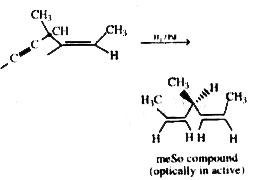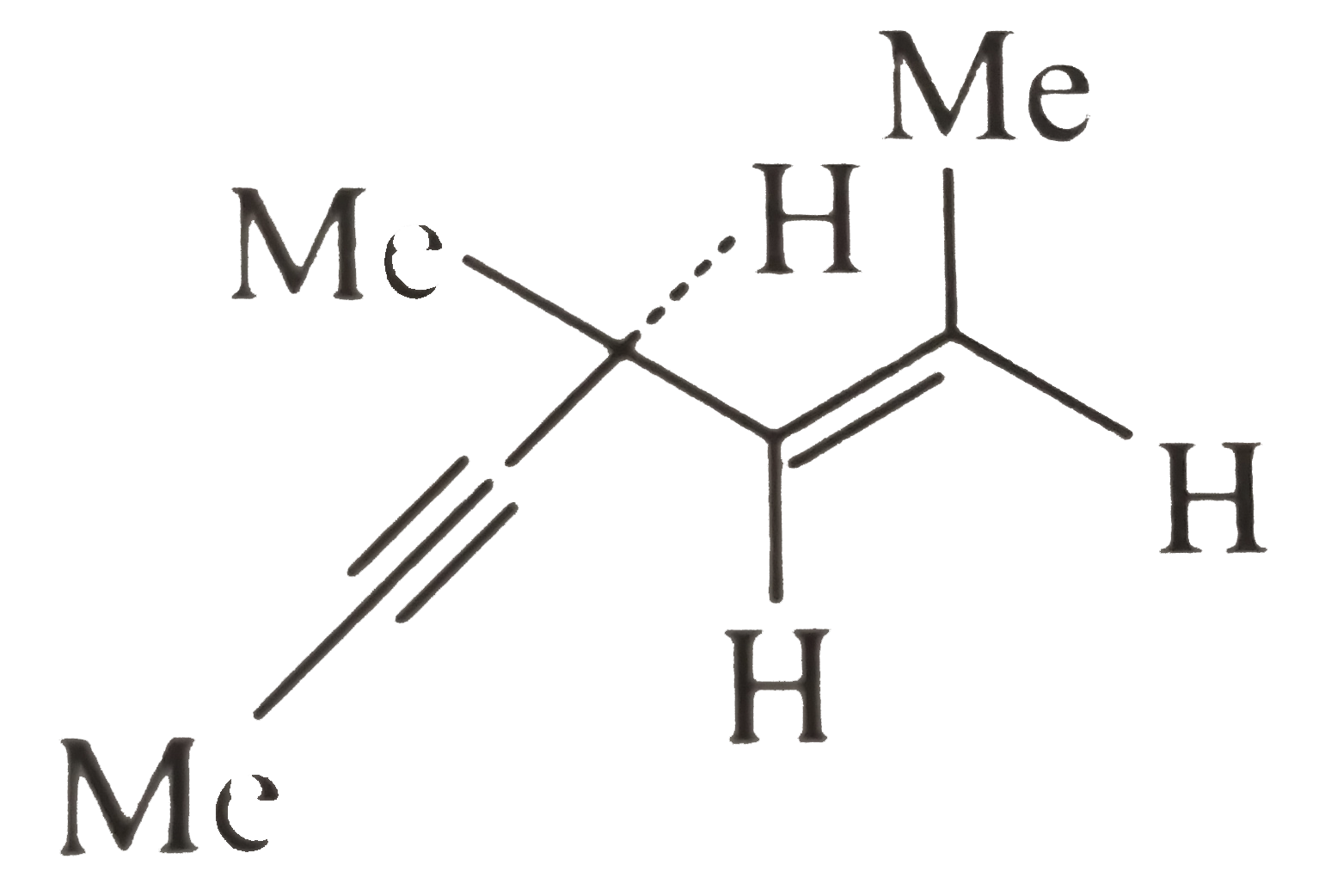Hydrogenation of adjoining compound in the presence of poisoned palladium catalyst gives
 Solution in Telugu
Solution in Telugu
An optically active compound
An optically inactive compound
A racemic inactive compound
A diastereomeric mixture
The correct Answer is:B
Hydrogenation with poisoned palladium brings about C is hydrogenation of Alkyne and does not affect double bond.

Topper's Solved these Questions
- HYDROCARBONSBOOK - AAKASH SERIESCHAPTER - HYDROCARBONSEXERCISE - LECTURE SHEET ( EXERCISE-III (ALKYNES PREPARATION AND GENERAL PROPERTIES, ALKYNES REACTIONS (MORE THAN ONE CORRECT ANSWER TYPE QUESTIONS )))
7 Videos
- HYDROCARBONSBOOK - AAKASH SERIESCHAPTER - HYDROCARBONSEXERCISE - LECTURE SHEET ( EXERCISE-III (ALKYNES PREPARATION AND GENERAL PROPERTIES, ALKYNES REACTIONS (LINKED COMPREHENSION TYPE QUESTION ( PASSAGE-I))))
2 Videos
- HYDROCARBONSBOOK - AAKASH SERIESCHAPTER - HYDROCARBONSEXERCISE - LECTURE SHEET ( EXERCISE-II (ALKENE PREPARTION, EELCTROPHILIC ADDITION REACTION , OXIDATION REACTION , REACTIONS OF ALKENE (INTEGER TYPE QUESTIONS )))
5 Videos
- GENERAL ORGANIC CHEMISTRYBOOK - AAKASH SERIESCHAPTER - GENERAL ORGANIC CHEMISTRYEXERCISE - QUESTIONS FOR DESCRIPTIVE ANSWERS
35 Videos
- HYDROGEN AND ITS COMPOUNDSBOOK - AAKASH SERIESCHAPTER - HYDROGEN AND ITS COMPOUNDSEXERCISE - QUESTIONS FOR DESCRIPTIVE ANSWERS
20 Videos
Similar Questions
Which sequence of reaction produce

View Solution1) The ≡C−H unit of an alkyne is more acidic than a C – H unit of an alkene or alkane, allowing acetylene and terminal alkynes to be converted to their conjugate bases ≡C.
2) Unlike alkenes, alkynes are reduced by metals, especially Li, Na and K.
3) Unlike alkenes, alkynes can undergo nucleophilic as well as electrophilic addition.

Which of the following best describes what happens in the first step in the mechanism of the hydrogen - deuterium exchange reaction shown?
CH3−C≡CDNaNH2−−−−→NH3CH3C≡CH
View SolutionTotal number of stereoisomeric products obtained by addition of bromine to 2-pentene.
View SolutionMention the hybridisation stste of each carbon in the following compounds.
CH3−CH=C=O,CH3−C≡C−CH3,CH3COCH3andCH2=CHCN
View SolutionWhy the use of hard water is disadvantages?
View Solution
Hydrogenation of the above compound in the presence of poisoned Pd catalyst gives:
View SolutionPhenol on hydrogenation in the presence of nickel catalyst at 160^(@)C gives
View SolutionHydrogenation of the adjoining compound in the presence of poisoned palladium catalyst gives.
View SolutionHydrogenation of the adjoining compound in the presence of poisoned palladium catalyst gives

View SolutionHydrogenation of the given compound in the presence of poisoned palladium catalyst gives :

View Solutionज़हरीले पैलेडियम उत्प्रेरक की उपस्थिति में निम्न योगिक के ह्य्द्रोजनीकरण से प्राप्त होता है

View SolutionOils on treating with hydrogen in the presence of palladium or nickel catalyst from fats. This is an example of
View SolutionUnsaturated hydrocarbons add hydrogen in the presence of catalyst such as ......... to give saturated hydrocarbons.
View SolutionOils on treating with hydrogen in the presence of palladium or nickel catalyst form fats. This is an example of …
View SolutionHydrogenation of the compound is achieved by the presence of toxic Me HH palladium catalyst.
View SolutionReduction of CH_3CH_2NC with hydrogen in presence of Ni or Pt as catalyst gives
View Solution
